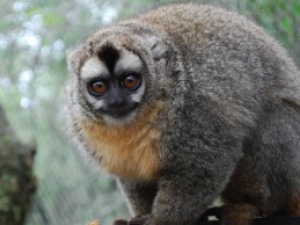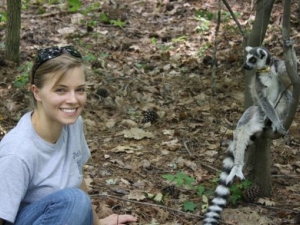For chimpanzees, just like humans, teasing, taunting and bullying are familiar parts of playground politics. An analysis of 12 years of observations of playground fights between young chimpanzees in East Africa finds that chimps with higher-ranked moms are more likely to win. The results come from an analysis of daily field notes recorded from 2000 to 2011 at Gombe National Park in western Tanzania. Stored in the Jane Goodall Institute Research Center at Duke University and also at… read more about Chimps With High-Ranking Moms Do Better In Fights »
During her junior year at Duke, Prim Siripipat '03 felt her tennis career was coming to an end.She had played since she was 7, training alongside a young Andy Roddick and rising as one of the top ten players in the United States by the time she was 17.But years of rigorous training and competing took its toll. Siripipat had three surgeries during that junior year -- on both of her shoulders and her left knee -- and she began thinking about her career options as she prepared to leave Duke."I knew I wanted to stay in sports… read more about For the Love of the Game »
Evolutionary Anthropology alumnus, Ben Finkel, has published a story about owl monkeys in Natural History Magazine. He is currently working as a research assistant for the Owl Monkey Project in Argentina. read more about EvAnth Alum publishes in Natural History Magazine »
In this 1965 photo from the Jane Goodall Institute Research Center at Duke, Goliath the alpha male gently interacts with an infant (age and identity unknown) while a female and her male infant sit very nearby at right. (© the Jane Goodall Institute / Hugo van Lawick, Feb. 1965) Nearly four decades of observations of Tanzanian chimpanzees has revealed that the mothers of sons are about 25 percent more social than the mothers of daughters. Boy moms were found to spend about two hours more per day with other… read more about Boy Moms More Social in Chimpanzees »
In a long-term study of interactions between chimpanzees in the famous Gombe National Park in Tanzania, researchers have found that males who consistently bully females tend to father more babies with their victims."Unfortunately it's true," said Anne Pusey, chair of evolutionary anthropology at Duke University. "But it does help us explain the pattern of male aggression we've seen between males and females in more than 50 years of observation."Although chimpanzees are genetically the closest relatives of humans, it's… read more about In Chimpanzees, Long-Term Bullying Makes More Babies »
Numerous studies have linked social interaction to improved health and survival in humans, and new research confirms that the same is true for baboons.A long-term study of more than 200 wild female baboons from the plains of southern Kenya finds that the most sociable females –- measured by how often they engaged in social grooming relative to their peers -- live two to three years longer than their socially isolated counterparts.Socializing with males gave females an even bigger longevity boost than socializing with other… read more about Lady Baboons With Guy Pals Live Longer »
The government of Argentina is awarding the Dr. Luis Federico Leloir Prize for international cooperation in science, technology and innovation to Richard F. Kay, professor of evolutionary anthropology, who has worked with Argentinian colleagues for 23 years. The prize is named for the Argentine doctor and biochemist Luis Federico Leloir (1906-1987) who received the 1970 Nobel Prize in Chemistry. Kay will receive the award from the Ministry of Science, Technology and Productive Innovation on November 17th, in Buenos Aires. read more about Richard Kay to receive Argentinian science prize »
Evolutionary Anthropology alumnus, Robert Cieri, was featured in a recent issue of Archeology Magazine. This work is based on his senior thesis research with Dr. Steve Chuchill. read more about EvAnth Alum featured in Archeology Magazine »
When Bob Cieri first arrived at Duke, he envisioned becoming an ecologist who worked in the field, not someone who’d flourish in a lab. All that changed during his four years at Duke. Now, three years out and happily ensconced in his first year of graduate school in biology at the University of Utah, Cieri recently was lead author on a published study that started as his honors thesis at Duke. The study theorizes that human society advanced when testosterone levels dropped and people started being more cooperative. The… read more about Lead Author Learned to Love Research at Duke »
An evolutionary anthropology student is discovering that playing games with service dogs may shed light on how humans evolved. Junior Ben Allen's research this summer at Canine Center for Independence (CCI) in California is sponsored by the Duke Canine Cognition Center and Associate Professor of Evolutionary Anthropology Brian Hare’s lab. As a pre-veterinary student from Devon, Pa., Allen said he enjoys his research because it allows him to interact directly with the dogs and study their behavior. Eventually Allen, who is… read more about Ben Allen: Researching Dogs to Learn About Humans »
Modern humans appear in the fossil record about 200,000 years ago, but it was only about 50,000 years ago that making art and advanced tools became widespread. A new study appearing Aug. 1 in the journal Current Anthropology finds that human skulls changed in ways that indicate a lowering of testosterone levels at around the same time that culture was blossoming. "The modern human behaviors of technological innovation, making art and rapid cultural exchange probably came at the same time that we developed a more cooperative… read more about Society Bloomed With Gentler Personalities and More Feminine Faces »
Kathleen Grogran (PhD, 2014) shares a moment with Aracus, a ring-tailed lemur at the Duke Lemur Center. Grogan’s research involved, among other things, exploring the ways in which genetic diversity in the Major Histocompatibility Complex was advertised through scent marking in both captive and wild lemurs. read more about Kathleen Grogran (PhD, 2014) – Duke Lemur Center, Durham, NC »
PhD candidate India Schneider-Crease collects a urine sample from Talisman, a male gelada baboon (seen sitting on the rock to her right) in the Simien Mountains National Park, Ethiopia. Schneider-Crease’s research examines tapeworm infections in gelada populations in order to identify the factors contributing to tapeworm susceptibility, and how tapeworm infections affect fitness. read more about India Schneider-Crease (PhD candidate) – Simien Mountains National Park, Ethiopia »
Sophomore Emma Wellbaum spends her days at the Duke Lemur Center learning about group dynamics in primitive primates.The prospective evolutionary anthropology and environmental sciences and policy double major is conducting an independent study with Julie Teichroeb, visiting assistant professor of evolutionary anthropology. They research leadership and group progression in red ruffed lemurs and black-and-white ruffed lemurs."Eventually we're going to be doing some trials that look at foraging efficiency and spatial position… read more about Emma Wellbaum: Close Watching of Lemur Social Dynamics »
An inquisitive meerkat collects behavioral data on PhD candidate Kendra Smyth in South Africa. Smyth studies reproductive endocrinology and ecological immunology in a wild population of meerkats in the Kalahari Desert. read more about Kendra Smyth (PhD candidate) – Kalahari Desert, South Africa »
Today, Madagascar sucker-footed bats live nowhere outside their island home, but new research shows that hasn't always been the case. The discovery of two extinct relatives in northern Egypt suggests the unusual creatures, which evolved sticky footpads to roost on slick surfaces, are primitive members of a group of bats that evolved in Africa and ultimately went on to flourish in South America.A team of researchers described the two bat species from several sets of fossilized jawbones and teeth unearthed in the Sahara. The… read more about Sucker-footed Fossils Broaden the Bat Map »
The strength of a lemur couple's bond is reflected by the similarity of their scents, finds a new study."It's like singing a duet, but with smells instead of sounds," said Christine Drea, a Duke University professor who supervised the study.Duke researchers sampled and analyzed scent secretions produced by lemurs known as Coquerel's sifakas living at the Duke Lemur Center in Durham. The researchers also monitored the animals' scent-marking and sniffing behavior across the breeding season.They found that lemur lovers mirror… read more about Lemur Lovers Sync Their Scents »
When monkeys landed in South America 37 or more million years ago, the long-isolated continent already teemed with a menagerie of 30-foot snakes, giant armadillos and strange, hoofed mammals. Over time, the monkeys forged their own niches across the New World, evolved new forms and spread as far north as the Caribbean and as far south as Patagonia. Duke University evolutionary anthropologist Richard Kay applied decades' worth of data on geology, ancient climates and evolutionary relationships to uncover several… read more about Reconstructing the New World Monkey Family Tree »
PhD candidate Lauren Gonzales pictured in Patagonia, Argentina in 2013. She was there for fossil prospecting in Miocene-aged deposits along the Rio Santa Cruz. Gonzales studies the role of evolution in sensory anatomy in the major adaptive radiations of primates. Her fieldwork in Argentina is focused on improving the representation of early South American fossil primates. read more about Lauren Gonzales (PhD candidate) – Rio Santa Cruz, Patagonia, Argentina »
It's pretty hard to pin down Charlie Nunn when you ask him to describe his science. He calls himself a behavioral ecologist, but get him wound up and he starts to sound like an epidemiologist or a primatologist. He joins Duke this term as a professor of both evolutionary anthropology and global health.Nunn says his work fits in three big areas. Besides the evolution of sleep, he's interested in primate behavior and ecology, the work he started doing at Duke as a grad student with Carel Van Schaik. But most of his work… read more about Charles Nunn: The Big Picture on Human Health and Disease »
The last time Sheila Patek was at Duke, she was riding a unicycle across a parking lot to fulfill the infamous "circus trick" requirement for Steve Nowicki's Ph.D. students. Now 12 years later, she's back and heading up her own lab, where she studies the ocean-dwelling crustaceans, including one that throws one of nature's hardest punches.In her time away from Duke, she's headed labs at Berkeley and UMass-Amherst, given a TED talk (see below), appeared on TV and radio shows, had two children, and ridden thousands of miles… read more about Sheila Patek: Research With a Powerful Punch »
Joseph Feldblum (Ph.D. candidate: foreground) learning the ways of the forest during his first field season studying chimpanzees in Gombe National Park, Tanzania. read more about Joseph Feldblum (Ph.D. candidate) in Gombe National Park, Tanzania »
In Gombe National Park, Tanzania, Ph.D. candidate Emily Boehm (foreground) observes Bahati--a pregnant female chimpanzee who is also displaying an estrous swelling. Boehm's dissertation probes the adaptive value of these deceptive sexual signals. read more about Emily Boehm (Ph.D. candidate) in Gombe National Park, Tanzania »








